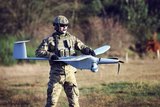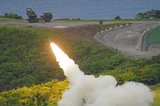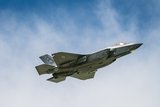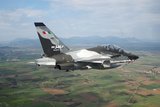US to deploy drones for chemical and biological threat detection
Initially, the DoD will acquire four SkyRaider UAS with new CBRN sensor payloads. (Photo: Teledyne FLIR)
Teledyne FLIR Defense on 9 February announced that it had been awarded a $13.3 million contract by the US DoD to extend the capabilities of its R80D SkyRaider UAS to autonomously carry out chemical, biological, radiological and nuclear (CBRN) reconnaissance missions.
The company will integrate flight control software that enables the SkyRaider to fly CBRN missions currently performed by soldiers hand-carrying sensors into hazardous areas.
Teledyne FLIR will produce prototype chemical and radiological sensor payloads for the UAV, as well as integrate existing US Army detector equipment. This contract follows three years of work by multiple joint programme offices to develop UAS capabilities for CBRN applications.
David Cullin, VP of technology and product management at Teledyne FLIR Defense, said: 'Employing unmanned air and ground assets to assess risks from weapons of mass destruction is an increasingly sought-after capability. We’ll continue our customers’ important work to enhance situational awareness for mounted and dismounted operations, enabling greater manouevrability on future CBRN-contested battlefields.'
The company already offers a family of CBRN sensor payloads for UAS– the MUVE C360, MUVE B330, and MUVE R430.
The SkyRaider and its developmental payloads will be designed to operate with the C2 user interface on the US Army’s Nuclear, Biological and Chemical Reconnaissance Vehicle (NBCRV) Stryker vehicle, for which Teledyne FLIR Defense is prime systems integrator.
For the base contract, the company will deliver four SkyRaiders and six of each sensor payload, with options to support training and documentation, plus the delivery of additional UAS and payloads. Initial deliveries are scheduled for autumn 2023.
Related Equipment in Defence Insight
More from Air Warfare
-
![What might next-generation military aircrew training look like?]()
What might next-generation military aircrew training look like?
Changing roles for combat aircraft fleets, the rise of simulation and LVC technologies, and the increasing cost of flight hours could all be leading to a paradigm shift in military pilot training.
-
![2025 air market review: European defence independence, next-gen tech and export concerns dominate]()
2025 air market review: European defence independence, next-gen tech and export concerns dominate
This year’s (geo)political turmoil has challenged many long-prevailing assumptions, leading to far-reaching consequences for air forces and their supplier bases in industry worldwide – with five key trends in review for 2025.
-
![Portugal signals interest in establishing A-29N final assembly line]()
Portugal signals interest in establishing A-29N final assembly line
As the launch customer for the NATO-configured variant, Portugal also took delivery of the first five A-29N aircraft from its order for 12, placed in 2024.
-
![Podcast: Critical Care episode 5 - Sustaining Europe’s frontline from Heidelberg]()
Podcast: Critical Care episode 5 - Sustaining Europe’s frontline from Heidelberg
As Europe ramps up defence investment in the wake of the Ukraine crisis, the spotlight is turning to how nations sustain their growing fleets.
-
![Leonardo signs contract on Austria’s M-346 aircraft order]()
Leonardo signs contract on Austria’s M-346 aircraft order
The first of the 12 M-346 aircraft are expected to be delivered to the Austrian Air Force by 2028, according to the company.























